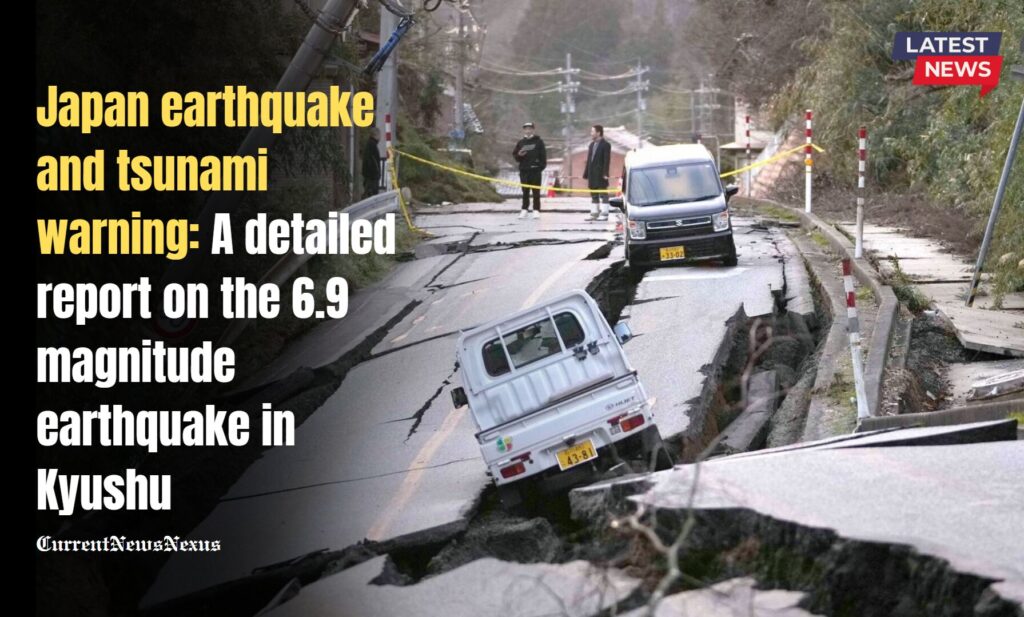Japan earthquake and tsunami warning: A detailed report on the 6.9 magnitude earthquake in Kyushu
January 13, 2025 – Japan has once again been reminded of its vulnerability to natural disasters, as a powerful 6.9 magnitude earthquake struck the southwestern region, particularly near Kyushu Island. The earthquake, which struck at 9:19 p.m. local time, has prompted authorities to issue a tsunami warning for Miyazaki and Kochi prefectures. This detailed report will provide an in-depth analysis of the event, its impact, and response efforts.

Earthquake: Key details and immediate impact
The earthquake struck near Kyushu Island, particularly affecting Miyazaki Prefecture. According to the Japan Meteorological Agency (JMA), the epicenter was located at a depth of about 30 km (18.6 mi). The powerful tremors were felt over a large area, causing immediate concern among residents and officials.
The 6.9 magnitude earthquake is classified as powerful, capable of causing significant damage, especially to buildings and infrastructure that are not designed to withstand such forces. Fortunately, initial assessments indicate that there has been no major structural damage or widespread devastation. However, the earthquake caused minor damage such as cracks in walls and fallen objects inside homes and businesses.
One of the immediate effects of the earthquake was disruption to public transportation. Trains were temporarily halted for safety inspections, and many flights were delayed or rerouted. Local authorities immediately mobilized emergency response teams to assess the situation and provide assistance to affected residents.
Tsunami advisory and precautions
In the wake of the earthquake, the JMA issued a tsunami advisory for coastal areas of Miyazaki and Kochi prefectures. The advisory cautions that waves up to 1 meter (3.2 feet) in height might strike the coast within 30 minutes following the earthquake. Residents in these areas have been urged to move to higher ground as a precaution.
Two small tsunamis measuring about 20 centimetres (0.7 ft) were detected at ports in the region. Although these waves were relatively small, the advisory highlighted the potential danger of larger waves and the importance of following evacuation orders. Coastal residents, in particular in Kochi, were instructed to evacuate as a precaution.
The issuance of the tsunami advisory and the subsequent evacuation underscored the importance of preparedness and prompt action in mitigating the risks posed by tsunamis. Japan’s advanced early warning system and well-practised evacuation protocols played a key role in ensuring the safety of residents.
Damage assessment and emergency response
Initial reports suggest limited structural damage occurred in areas hit by the quake. Public broadcaster NHK TV reported calm seas and normal traffic conditions in Miyazaki and Kochi prefectures, suggesting the immediate impact of the quake was less severe than initially feared. However, the full extent of the damage is still being assessed, and authorities are on alert for potential aftershocks.
One person was reported to have sustained minor injuries after falling from stairs during the earthquake. Medical teams were immediately dispatched to provide necessary care and ensure the well-being of residents. Emergency response teams, including firefighters, police and disaster relief personnel, were deployed to conduct a thorough inspection of buildings, roads and other critical infrastructure.
Authorities have also warned residents to be alert to landslides, especially in areas with steep slopes. The risk of landslides increases after strong earthquakes, and heavy rains may worsen the situation. Local governments have set up temporary shelters for evacuees and provided necessary assistance, including food, water and medical aid.
Historical context and seismic activity in Japan
Japan is located along the “Ring of Fire”, an arc of volcanoes and fault lines in the Pacific Basin. The region is highly seismically active, making Japan one of the world’s most earthquake-prone countries. The country has a long history of devastating earthquakes and tsunamis, including the devastating 2011 Tohoku earthquake and tsunami, which resulted in widespread destruction and loss of life.
The last major earthquake in the region occurred on January 1, 2024, with a magnitude of 7.5. This earthquake caused significant casualties and damage, prompting the Japanese government to invest heavily in disaster preparedness and response infrastructure. Lessons learned from past events have shaped Japan’s approach to managing seismic risks and increasing the resilience of its communities.
Japan’s advanced earthquake monitoring system, early warning technology and robust building codes have been instrumental in reducing the earthquake’s impact. The country’s dedication to research and innovation in seismic safety has made it a global leader in disaster management.
Public awareness and safety measures
Following the earthquake, officials have stressed the importance of public awareness and preparedness. Residents have been advised to stay informed through official channels and heed the warnings and instructions of local authorities. The JMA continues to monitor the situation and provide updates on potential aftershocks and tsunami risks.
Public safety campaigns and exercises have been the cornerstone of Japan’s disaster preparedness efforts. Schools, businesses and communities regularly participate in earthquake and tsunami drills to ensure that everyone knows how to respond in an emergency. The government’s efforts to educate the public about disaster preparedness have played a key role in reducing casualties and damage.
Stay tuned to currentnewsnexus for live updates and detailed analysis of news.




4 thoughts on “Japan earthquake and tsunami warning: A detailed report on the 6.9 magnitude earthquake in Kyushu”